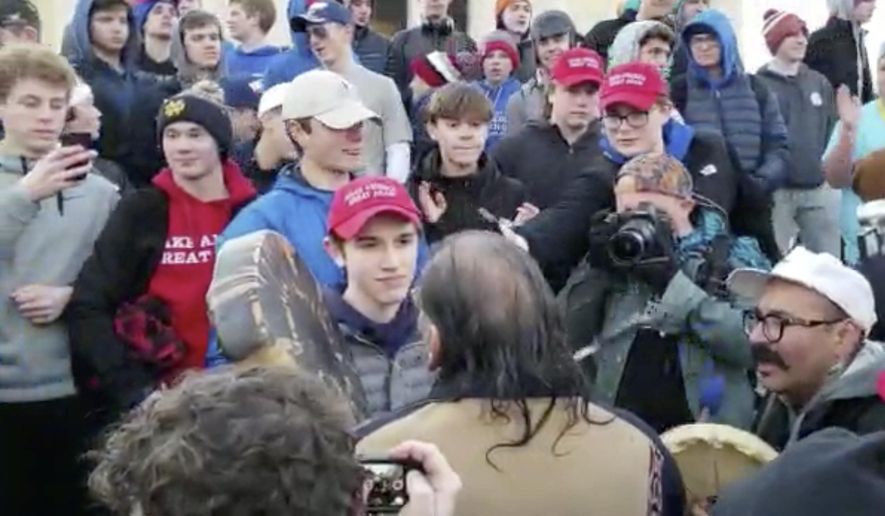Even if The Washington Post never pays him a dime, Kentucky teenager Nicholas Sandmann may have already earned a bust in the conservative pantheon for his audacious $250 million lawsuit against the liberal media titan.
President Trump led the cheers Wednesday, tweeting “Go get them Nick. Fake News!” after attorneys for the 16-year-old Covington Catholic High School student filed a defamation lawsuit over the newspaper’s coverage of his Jan. 18 faceoff with American Indian activist Nathan Phillips.
“I hope the jury gives the kid the entire $250 million! The only way to stop reckless reporting that ruins people’s lives is when they have to be responsible for what they do to people,” tweeted former Arkansas Gov. Mike Huckabee.
Whether the lawsuit will pass legal muster is another question. Winning a defamation judgment against a news publication is typically a longshot, and The Post has indicated it plans to fight the lawsuit.
Clay Calvert, who teaches media law at the University of Florida, said the complaint boils down to allegations that The Post “falsely accused, across multiple articles and either directly or by implication, Sandmann of instigating a confrontation with Nathan Phillips.”
Those allegations included “assaulting and intimidating Phillips, of engaging in racist conduct and of engaging in conduct that violates both the principles and policies of his religious community and his school,” Mr. Calvert said.
Representing the teen and his parents is L. Lin Wood of Atlanta, a prominent defamation attorney whose past clients included Richard Jewell, who was falsely suspected of the 1996 Olympic Park bombing, and the family of murder victim JonBenet Ramsey.
Even so, Eugene Volokh, UCLA School of Law professor, expressed doubts about the lawsuit’s chances of courtroom success.
“I just don’t think that this lawsuit is going far,” Mr. Volokh said. “But then again, there might be some particular things that either a court will characterize differently than I do.”
He noted that statements described in the lawsuit as “false and defamatory” could be interpreted as matters of opinion, such as reporting in the Jan. 19 story that Nicholas “wore a relentless smirk” and that the teens “swarmed” Mr. Phillips.
“With a complaint like this, there are so many allegations,” said Mr. Volokh, who runs the Volokh Conspiracy legal blog, which is posted on Reason.com but previously appeared on The Washington Post website.
“It may be that different ones will be treated differently, but at least for the bulk of the allegations, they strike me as for one reason or another as not the sort of thing likely to lead to liability,” he said. “Some of them are matters of opinion; some of them are not about Sandmann; some of them are forwarding something that some other online speaker has posted, and therefore is immune.”
The lawsuit, filed by Mr. Wood and Todd V. McMurtry of Fort Mitchell, Kentucky, seeks $250 million — the amount reportedly paid by Amazon founder Jeff Bezos to buy The Post in 2013 — in compensatory and punitive damages.
Don’t put too much stock in that figure, Mr. Calvert said.
“It’s not unusual for plaintiffs to ask for vast sums of money in libel cases,” he said. “That is par for the legal course.”
The complaint also identifies Nicholas Sandmann as a private figure, which would allow him to recover the requested $50 million in compensatory damages based on a finding of negligence, as opposed to the actual malice standard required for public figures.
“He’d still need to prove something more — namely, what courts call actual malice — to recover the $200 million he wants in punitive damages,” Mr. Calvert said. “To prove actual malice, Sandmann would need to show that The Washington Post either knew the allegedly defamatory statements were false when it published them or that it acted with reckless disregard for whether they were true or false.”
That’s a high legal bar. Another hurdle for the teen is proving that he deserves compensatory damages, given that he’s a high school student and not, say, a business owner threatened with loss of income.
“The negligence standard only applies — even for private figures — as proven compensatory damages, and in this kind of situation, I think that compensatory damages are going to be really hard to prove,” Mr. Volokh said. “It’s going to be all about the presumed and punitive damages, and for that, you generally have to show knowledge of falsehood or likely falsehood.”
Of course, there are other reasons to file defamation lawsuits even if the likelihood of a court victory is slim. One motivation would be to make a public statement. Another would be to cast doubt on the reliability of the defendant.
“Regardless of where the lawsuit goes, it will highlight the way that the newspapers behaved here, particularly in this case the way The Post behaved here,” said Mr. Volokh, including “to the extent that The Post was too quick to rush to judgment here, to the extent that it perhaps gave too much credit to one side of the story.”
“Even if they [the defendants] win in court, the lawsuit may kind of inform people of that,” Mr. Volokh said.
What about an out-of-court settlement? “My understanding is newspapers are quite reluctant to settle in these kinds of cases, especially when they have a pretty strong position. They don’t want follow-on lawsuits,” Mr. Volokh said.
The attorneys for the Sandmann family have indicated that they plan to file more lawsuits, identifying 54 potential defendants, including news outlets, celebrities and dioceses.
An independent investigation commissioned by the Diocese of Covington issued a report last week exonerating the group of teenagers of instigating the incident at the Lincoln Memorial.
The boys were waiting for their buses home from the March for Life when they were approached by Mr. Phillips, who was singing and beating a drum, but the teens were initially accused of harassing the older man.
• Valerie Richardson can be reached at vrichardson@washingtontimes.com.




Please read our comment policy before commenting.